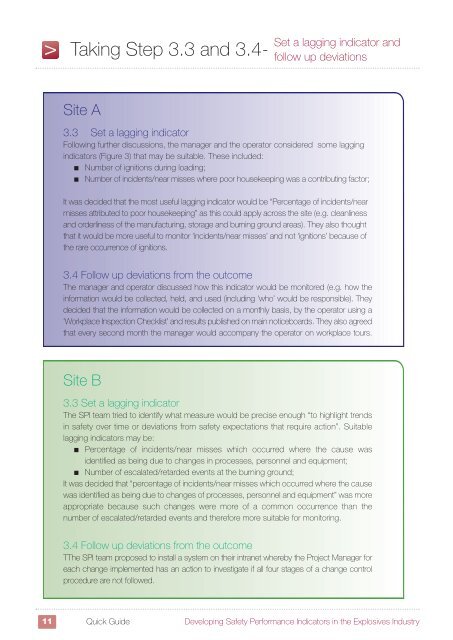RR909 - Safety performance indicators in the explosives sector - HSE
RR909 - Safety performance indicators in the explosives sector - HSE
RR909 - Safety performance indicators in the explosives sector - HSE
You also want an ePaper? Increase the reach of your titles
YUMPU automatically turns print PDFs into web optimized ePapers that Google loves.
V<br />
Tak<strong>in</strong>g Step 3.3 and 3.4<br />
Site A<br />
Set a lagg<strong>in</strong>g <strong>in</strong>dicator and<br />
follow up deviations<br />
3.3 Set a lagg<strong>in</strong>g <strong>in</strong>dicator<br />
Follow<strong>in</strong>g fur<strong>the</strong>r discussions, <strong>the</strong> manager and <strong>the</strong> operator considered some lagg<strong>in</strong>g<br />
<strong><strong>in</strong>dicators</strong> (Figure 3) that may be suitable. These <strong>in</strong>cluded:<br />
n Number of ignitions dur<strong>in</strong>g load<strong>in</strong>g;<br />
n Number of <strong>in</strong>cidents/near misses where poor housekeep<strong>in</strong>g was a contribut<strong>in</strong>g factor;<br />
It was decided that <strong>the</strong> most useful lagg<strong>in</strong>g <strong>in</strong>dicator would be “Percentage of <strong>in</strong>cidents/near<br />
misses attributed to poor housekeep<strong>in</strong>g” as this could apply across <strong>the</strong> site (e.g. cleanl<strong>in</strong>ess<br />
and orderl<strong>in</strong>ess of <strong>the</strong> manufactur<strong>in</strong>g, storage and burn<strong>in</strong>g ground areas). They also thought<br />
that it would be more useful to monitor ‘<strong>in</strong>cidents/near misses’ and not ‘ignitions’ because of<br />
<strong>the</strong> rare occurrence of ignitions.<br />
3.4 Follow up deviations from <strong>the</strong> outcome<br />
The manager and operator discussed how this <strong>in</strong>dicator would be monitored (e.g. how <strong>the</strong><br />
<strong>in</strong>formation would be collected, held, and used (<strong>in</strong>clud<strong>in</strong>g ‘who’ would be responsible). They<br />
decided that <strong>the</strong> <strong>in</strong>formation would be collected on a monthly basis, by <strong>the</strong> operator us<strong>in</strong>g a<br />
‘Workplace Inspection Checklist’ and results published on ma<strong>in</strong> noticeboards. They also agreed<br />
that every second month <strong>the</strong> manager would accompany <strong>the</strong> operator on workplace tours.<br />
Site B<br />
3.3 Set a lagg<strong>in</strong>g <strong>in</strong>dicator<br />
The SPI team tried to identify what measure would be precise enough “to highlight trends<br />
<strong>in</strong> safety over time or deviations from safety expectations that require action”. Suitable<br />
lagg<strong>in</strong>g <strong><strong>in</strong>dicators</strong> may be:<br />
n Percentage of <strong>in</strong>cidents/near misses which occurred where <strong>the</strong> cause was<br />
identified as be<strong>in</strong>g due to changes <strong>in</strong> processes, personnel and equipment;<br />
n Number of escalated/retarded events at <strong>the</strong> burn<strong>in</strong>g ground;<br />
It was decided that “percentage of <strong>in</strong>cidents/near misses which occurred where <strong>the</strong> cause<br />
was identified as be<strong>in</strong>g due to changes of processes, personnel and equipment” was more<br />
appropriate because such changes were more of a common occurrence than <strong>the</strong><br />
number of escalated/retarded events and <strong>the</strong>refore more suitable for monitor<strong>in</strong>g.<br />
3.4 Follow up deviations from <strong>the</strong> outcome<br />
TThe SPI team proposed to <strong>in</strong>stall a system on <strong>the</strong>ir <strong>in</strong>tranet whereby <strong>the</strong> Project Manager for<br />
each change implemented has an action to <strong>in</strong>vestigate if all four stages of a change control<br />
procedure are not followed.<br />
11 Quick Guide Develop<strong>in</strong>g <strong>Safety</strong> Performance Indicators <strong>in</strong> <strong>the</strong> Explosives Industry

















